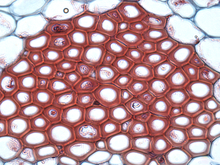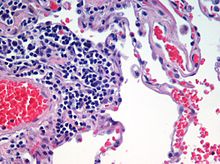his article is about
biological tissue. For the moth,
see Triphosa dubitata. For other uses,
see Tissue (disambiguation).

Cross section of sclerenchyma
fibers in plant ground
tissue.

Microscopic view of a
histologic specimen of
human lung tissue stained
with hematoxylin and eosin.
In biology, tissue is a cellular
organizational level
between cells and a
complete organ. A tissue is an ensemble of
similar cells and their extracellular
matrix from the same origin
that together carry out a specific function. Organs are then formed
by the functional grouping together of multiple
tissues.
The English word is derived
from the French tissu, meaning something that is
woven, from the verb tisser, "to
weave".
The study of human and animal
tissues is known as histology or, in connection with
disease, histopathology. For plants, the discipline
is called plant
anatomy. The classical tools for
studying tissues are the paraffin
block in which tissue is
embedded and then sectioned,
the histological
stain, and
the optical
microscope. In the last couple of
decades,[clarification
needed] developments
in electron
microscopy, immunofluorescence, and the use
of frozen tissue
sections have enhanced the detail
that can be observed in tissues. With these tools, the classical
appearances of tissues can be examined in health
and disease, enabling considerable
refinement of medical
diagnosis and prognosis



















